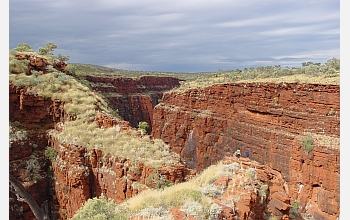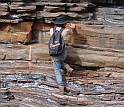News Release 07-127
Oxygen on Earth: 50 to 100 Million Years Earlier Than Scientists Thought
Environmental changes preceded first great rise in atmospheric oxygen

Oxygen has been found before this formation of iron oxide, or rust, in Western Australia.
September 27, 2007
This material is available primarily for archival purposes. Telephone numbers or other contact information may be out of date; please see current contact information at media contacts.
Scientists have found that traces of oxygen appeared in Earth's atmosphere 50 to 100 million years earlier than previously thought--before what geologists call the "Great Oxidation Event."
This event happened between 2.3 and 2.4 billion years ago, when most geoscientists think atmospheric oxygen rose sharply from very low levels. The amount of oxygen before that time has been uncertain.
Analyzing layers of sedimentary rock in a kilometer-long core sample from the Hamersley Basin in Western Australia, the researchers report finding evidence that a small but significant amount of oxygen--a whiff--was present in the oceans and possibly Earth's atmosphere 2.5 billion years ago.
The data also suggest that oxygen was nearly undetectable just before that time. Their findings appear in a pair of papers in the Sept. 28 issue of the scientific journal Science. The National Science Foundation (NSF) funded the research.
"We seem to have captured a piece of time before the Great Oxidation Event during which the amount of oxygen was actually changing--caught in the act, as it were," said Ariel Anbar, a biogeochemist at Arizona State University in Tempe.
Anbar led one of the teams of investigators and participated in another team led by Alan Jay Kaufman, a geochemist at the University of Maryland in College Park. The collaborators analyzed a drill core for geochemical and biological tracers representing the time just before the rise of atmospheric oxygen.
"We have compelling evidence for a shift in the oxidation state of the surface ocean 50 million years before the Great Oxidation Event," said Kaufman. "These findings are a significant step in our understanding of the oxygenation of Earth. They link changes in the environment with changes in the biosphere."
The project also brought together scientists from the University of Washington, University of California in Riverside and University of Alberta.
"These results are the culmination of a successful effort to recover suitable rock material, and to test hypotheses regarding the evolution of biogeochemical cycles on Earth in the time period after the appearance of life and prior to the Great Oxidation Event," said Enriqueta Barrera, program director in NSF's Division of Earth Sciences, which funded the research.
The work also received support from the Astrobiology Drilling Program (ADP) of the NASA Astrobiology Institute (NAI) and the Geological Survey of Western Australia.
In the summer of 2004, the scientists bored into the geologically-famous Hamersley Basin in Western Australia, extracting a core of sedimentary rock 908 meters (about 3,000 feet) long.
"The core provides a continuous record of environmental conditions, analogous to a tape recording," explains Anbar. Because it was recovered from deep underground, it contains materials untouched by the atmosphere for billions of years.
Anbar and his research group began an analysis of selected bands of the late Archean Mt. McRae Shale found in the upper 200 meters of the drill core. They analyzed amounts of the trace metals molybdenum, rhenium and uranium. The amounts of these metals in oceans and sediments depends on the amount of oxygen in the environment.
The goal was to characterize the nature of the environment and life in the oceans leading up to the Great Oxidation Event.
"The Maryland group began seeing funny variations in the chemistry of sulfur along this stretch of the drill core," said Anbar. "We sped up our research to see if we found variations in metal abundances in the same places - and we did."
Finding evidence of oxygen some 50 to 100 million years earlier than what was previously known was completely unexpected, say the scientists.
For the first half of Earth's 4.56-billion-year history, the environment held almost no oxygen, other than that bound to hydrogen in water or to silicon and other elements in rocks. "Then, some time between 2.3 and 2.4 billion years ago, oxygen rose sharply in the Earth's atmosphere and oceans, during the 'Great Oxidation Event,'" said Anbar.
The event was a major step in Earth's history, said Anbar, but its cause remains unexplained. How did Earth's atmosphere go from being oxygen-poor to oxygen-rich, why did it change so quickly, and why did its oxygen content stabilize at the present 21 percent?
"Studying the dynamics that gave rise to the presence of oxygen in Earth's atmosphere deepens our appreciation of the complex interaction between biology and geochemistry," said Carl Pilcher, director of the NAI. "The results support the idea that our planet and the life on it evolved together."
One possibility for explaining the Great Oxidation Event is that the ancient ancestors of today's plants first began to produce oxygen by photosynthesis at this time.
"What we have now are new lines of evidence for oxygen in the environment 50 to 100 million years before its big rise," Anbar said. This discovery strengthens the notion that organisms produced oxygen long before the Great Oxidation Event, creating features in the geologic record such as banded iron formations, and that the rise of oxygen in the atmosphere was ultimately controlled by geological processes.
"This knowledge is relevant to today's studies of environmental and climate issues because it helps us understand the interactions between biology, geology and the composition of the atmosphere," Anbar said.
"It also has implications for the search for life on planets outside our solar system. In the near future the only way we can look for evidence of life in such far-off places is to look for the fingerprints of biology in the compositions of their atmospheres. We are not far off from being able to detect Earth-like planets elsewhere in the galaxy, and eventually, we will be able to use telescopes to measure the oxygen content of their atmospheres."
Questions Anbar hopes to investigate include: if scientists find that no Earth-like planets have undergone Great Oxidation Events, what will that mean about life on Earth? Is it inevitable that the evolution of oxygen-producing organisms results in an oxygen-rich atmosphere?
And, he said: "Can we find evidence that oxygen was produced even earlier?"
-NSF-
-
Scientist Roger Buick, a co-author of the papers, conducts research in Western Australia.
Credit and Larger Version -
In this sediment core are traces of oxygen on Earth 50-100 million years earlier than thought.
Credit and Larger Version
Media Contacts
Cheryl Dybas, NSF, (703) 292-7734, email: cdybas@nsf.gov
Carol Hughes, ASU, (480) 965-6375, email: carol.hughes@asu.edu
Michael Mewhinney, NASA, (650) 604-3937, email: michael.mewhinney@nasa.gov
Lee Tune, UMD, (301) 405-4679, email: ltune@umd.edu
The U.S. National Science Foundation propels the nation forward by advancing fundamental research in all fields of science and engineering. NSF supports research and people by providing facilities, instruments and funding to support their ingenuity and sustain the U.S. as a global leader in research and innovation. With a fiscal year 2023 budget of $9.5 billion, NSF funds reach all 50 states through grants to nearly 2,000 colleges, universities and institutions. Each year, NSF receives more than 40,000 competitive proposals and makes about 11,000 new awards. Those awards include support for cooperative research with industry, Arctic and Antarctic research and operations, and U.S. participation in international scientific efforts.
Connect with us online
NSF website: nsf.gov
NSF News: nsf.gov/news
For News Media: nsf.gov/news/newsroom
Statistics: nsf.gov/statistics/
Awards database: nsf.gov/awardsearch/
Follow us on social
Twitter: twitter.com/NSF
Facebook: facebook.com/US.NSF
Instagram: instagram.com/nsfgov




